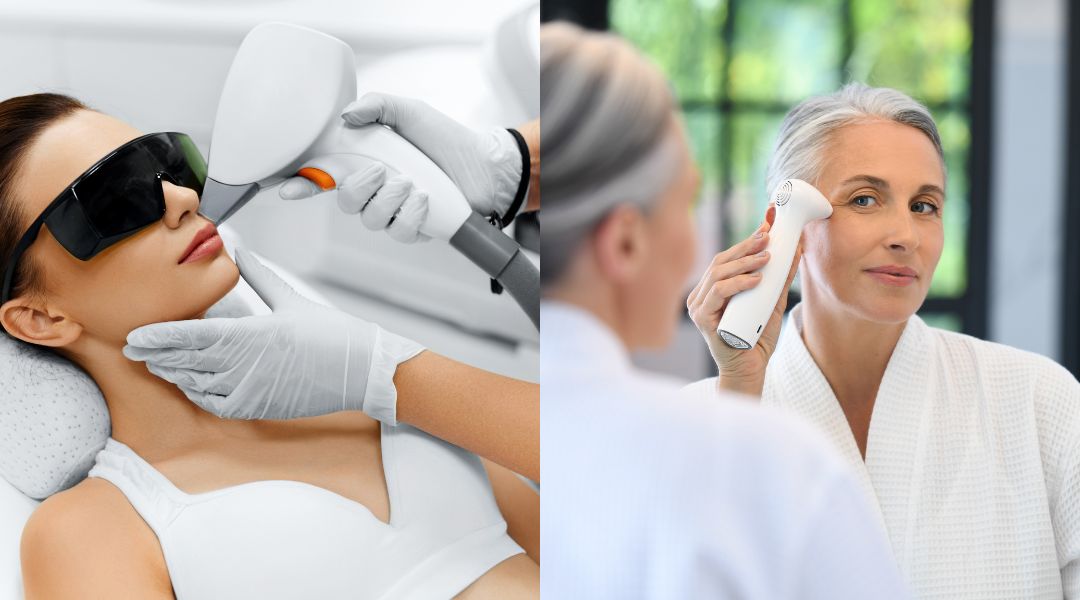TL;DR
Ablative lasers resurface skin for faster, more dramatic results but come with pain, downtime, and higher risk; non-ablative lasers stimulate collagen beneath the surface for gradual improvements with minimal downtime. If you prefer a gentler, at-home option, NIRA’s non-ablative, non-fractional laser is designed for comfort and daily use, with visible results in ~10–12 weeks. Action: choose based on your goals, timeline, and downtime tolerance—then consider NIRA to maintain and minimize wrinkles at home.
With countless skincare options available, it can be overwhelming to choose the right approach for your specific needs. Each type of laser treatment has its own set of benefits and considerations, and the best choice will depend on a variety of factors including the specific skin concern being addressed, the desired results, how quickly results need to be seen, and the individual’s tolerance to pain and downtime.
Understanding the difference between ablative and non-ablative options is essential for making informed decisions about your skincare journey. But fear not! In this comprehensive guide, we will walk you through the differences between these two powerful laser treatments so that you’re able to make an informed decision about your skincare and choose the treatment that best meets your needs.
Understanding Laser Treatments
Laser treatments, a cornerstone of modern dermatology, have revolutionized the way we approach skincare. Lasers are used to target specific skin cells or issues without affecting the surrounding tissues. These treatments utilize focused light, tuned to specific wavelengths, to target and treat various skin conditions. The laser’s energy is absorbed by targeted cells in the skin, which respond by triggering a healing response that promotes the growth of new, healthy skin.
There are two main types of lasers used in skincare: ablative and non-ablative.
Ablative Laser Treatments

Ablative lasers work by removing the outermost layer of the skin, essentially vaporizing the damaged skin cells. This process stimulates the body’s natural healing response, leading to the production of new, healthy skin cells. These treatments can be highly effective in addressing wrinkles, scars, and sun damage. However, they often are painful,involve a more intensive recovery period, and carry a higher risk of side effects including infection and changes in skin color. This type of treatment can lead to a longer recovery period and potential side effects, including redness, swelling, and a risk of infection. Ideal candidates for ablative treatments are those seeking dramatic improvements quickly and are prepared for a more involved recovery and downtime process.
Non-Ablative Laser Treatments

In contrast, non-ablative lasers work differently. Non-ablative treatments work by creating small columns of damaged or dead skin cells that heal over time. Unlike ablative treatments, they do not create empty holes in the skin, making the healing process less invasive and more comfortable. Instead of removing the skin’s surface, they send laser light into the dermis, the skin’s second layer, without harming the surface. This process triggers the cells to rebuild natural collagen over time, without the pain or damage. Non-ablative treatments typically have a shorter recovery time and fewer side effects than ablative treatments. They are ideal for individuals seeking gradual improvements with minimal downtime.
Ablative vs. Non-Ablative: The Considerations
When choosing between ablative and non-ablative laser treatments, it’s essential to consider your skin’s needs, your pain tolerance, and your lifestyle. Ablative lasers can provide dramatic results but come with a longer recovery time and potential side effects. Non-ablative lasers, on the other hand, offer a gentler approach with less downtime but may require more treatments to achieve the desired results.
NIRA: A Non-Ablative, Non-Fractional Laser Solution

NIRA’s technology is a non-ablative and non-fractional laser solution. This means it’s designed to be less invasive and cause less discomfort than other types of laser treatments. It works by sending laser light into the dermis, the second layer of the skin, triggering cells to rebuild natural collagen without harming the skin’s surface or removing any tissue. This process gently heats the skin, but the temperature stays below the pain threshold, ensuring a comfortable and painless experience. When used daily, users can expect to see results in 10-12 weeks.
For those seeking a balance between natural skincare and professional treatments, our skin renewing lasers serve as an effective maintenance plan, proven to minimize wrinkles.
The Future of NIRA
Ablative treatments provide remarkable results by resurfacing the skin and addressing deep-seated concerns, while non-ablative treatments offer a gentler approach with minimal downtime and gradual improvements. The choice between these two techniques ultimately depends on your specific needs, skin condition, and desired outcomes.
At NIRA, we are committed to providing high-level, effective skincare solutions that empower individuals to take control of their skincare journey at home.
Explore the science behind NIRA and discover how our non-ablative, non-fractional laser technology can fit into your skincare routine.


















